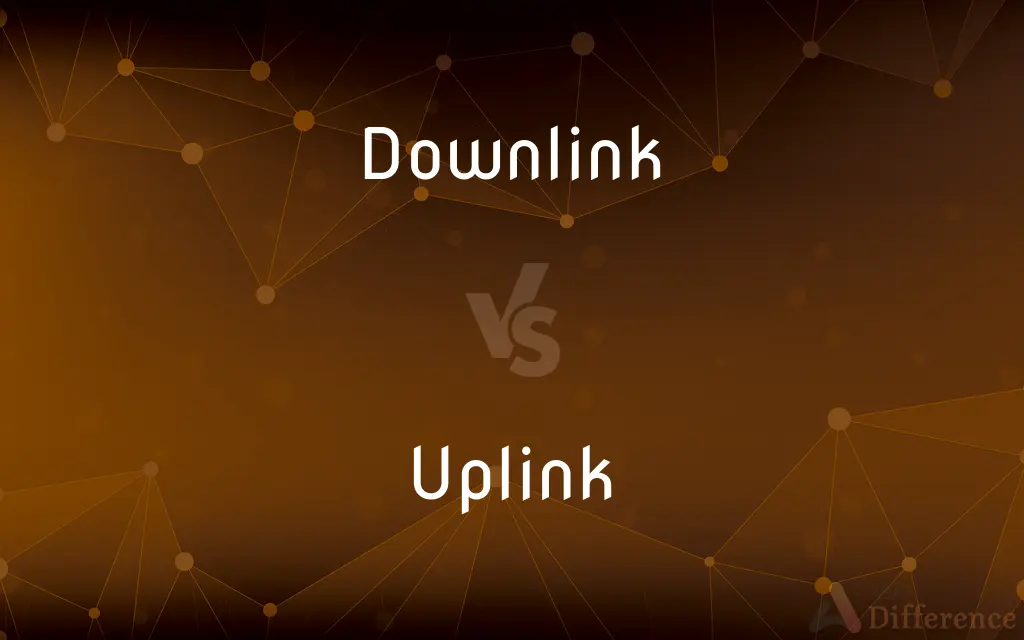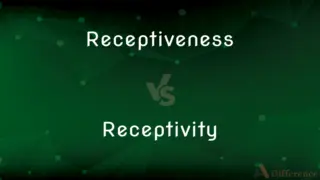Downlink vs. Uplink — What's the Difference?
By Urooj Arif & Fiza Rafique — Updated on April 1, 2024
Downlink involves the transmission of data from a satellite or tower to a receiver, while uplink refers to the transmission from a receiver to a satellite or tower.

Difference Between Downlink and Uplink
Table of Contents
ADVERTISEMENT
Key Differences
Downlink and uplink are terms commonly used in telecommunications to describe the two directions of data transmission in a communication system. The downlink is the path from the satellite or cellular tower to the device, such as a smartphone, computer, or television. This direction is typically used for receiving data, such as streaming a video or downloading files. On the other hand, the uplink is the path from the device back to the satellite or tower, used for sending data, like uploading a photo to social media or sending an email.
The frequencies used for downlink and uplink are usually different to prevent interference, allowing for simultaneous two-way communication. Downlink generally has higher bandwidth allocations compared to uplink, reflecting the common need for greater download speeds for activities such as streaming and downloading. Conversely, uplink requires less bandwidth since activities like sending emails or uploading photos generally consume less data.
In the context of satellite communication, the downlink is crucial for broadcasting services, such as satellite television or internet services, where information is transmitted over a wide area. The uplink, however, is vital for sending signals to the satellite, including user requests or data uploads. This distinction ensures efficient and effective communication between a user's device and the network infrastructure.
Both downlink and uplink are essential for the functionality of cellular networks, satellite communications, and other wireless communication systems, ensuring a seamless exchange of data. The optimization of both paths is crucial for maintaining network efficiency, speed, and reliability, with advancements in technology continuously improving the capacity and performance of both downlink and uplink transmissions.
Comparison Chart
Direction of Transmission
From satellite/cellular tower to device.
From device to satellite/cellular tower.
ADVERTISEMENT
Purpose
Used for receiving data, e.g., streaming videos, downloading files.
Used for sending data, e.g., uploading photos, sending emails.
Frequency Band
Different from uplink to prevent interference; often higher bandwidth.
Different from downlink to prevent interference; often lower bandwidth.
Typical Usage
High bandwidth requirements for data download.
Lower bandwidth requirements for data upload.
Communication Example
Streaming a movie on a smartphone.
Uploading a picture from a smartphone to social media.
Compare with Definitions
Downlink
Aiming to increase speed and reliability for better user experience.
Advances in downlink technology have significantly improved video streaming quality.
Uplink
Transmission from a receiver to a satellite or tower.
Sending an email involves data transmission via uplink.
Downlink
Transmission from a satellite or tower to a receiver.
Watching a live broadcast on TV involves receiving data via downlink.
Uplink
Lower compared to downlink, tailored for uploading data.
Uplink speeds are designed to accommodate typical data upload activities.
Downlink
Crucial for broadcasting and content delivery.
Satellite TV services are delivered primarily through downlink frequencies.
Uplink
Essential for sending data or communications.
Uploading content to cloud storage requires reliable uplink transmission.
Downlink
Generally higher to support data-intensive activities.
Downlink capacities are optimized for high-speed internet streaming.
Uplink
Focuses on improving efficiency and upload speeds.
Technological enhancements in uplink paths have made cloud computing more accessible.
Downlink
Common in services requiring data downloading.
Downloading large files from the internet relies on downlink transmission.
Uplink
Vital for user interactions and data upload.
Social media platforms rely on uplink for user-generated content uploads.
Downlink
A transmission path for the communication of signals and data from a communications satellite or other space vehicle to the earth and back.
Uplink
A communication channel through which a user transmits data to the internet.
Downlink
(telecommunications) The transmission of a signal from a satellite to a receiving station on earth; or the means of this transmission.
Uplink
A transmission path by which radio or other signals are sent to an aircraft, spacecraft, or a communications satellite.
Downlink
(telecommunications) Transmission of data from a network, usually wireless, to the user.
Uplink
To transmit (data) by uplink.
Downlink
To transmit a signal from a satellite to a terrestrial receiving station.
Uplink
The portion of a communications link used for the transmission of signals from an Earth terminal to a satellite or to an airborne platform. An uplink is the converse of a downlink. An uplink or downlink is distinguished from reverse link or forward link.
Uplink
The communication path from a mobile device to a base station, a consumer to the network backbone, a client device to a server etc.
Uplink
Data transmission from a data station to the headend.
Uplink
To transmit a signal by means of an uplink.
Uplink
A transmission from Earth to a spacecraft or the path of such a transmission
Common Curiosities
What is downlink?
Downlink is the transmission of data from a satellite or cellular tower to a receiving device, used primarily for downloading or streaming content.
Why are different frequencies used for downlink and uplink?
Different frequencies prevent interference between the downlink and uplink transmissions, ensuring clear and reliable communication.
What is uplink?
Uplink refers to the transmission of data from a device up to a satellite or cellular tower, primarily used for sending or uploading data.
Can downlink and uplink speeds be different?
Yes, downlink speeds are often higher than uplink speeds to accommodate the greater demand for downloading data compared to uploading.
How do downlink and uplink work in a satellite communication system?
In satellite communication, downlink transmits data from the satellite to the user's receiver, while uplink sends data from the user's transmitter to the satellite.
What role does uplink play in social media?
Uplink is crucial for uploading and sharing user-generated content, such as photos and videos, on social media platforms.
Can interference occur between downlink and uplink?
Proper frequency planning and technology are used to minimize or eliminate interference between downlink and uplink transmissions.
How are downlink and uplink optimized in cellular networks?
Cellular networks optimize downlink and uplink frequencies and bandwidths to balance the demand for downloading and uploading data, ensuring efficient network performance.
Is the technology for downlink and uplink transmission the same?
While the fundamental technology is similar, specific optimizations and techniques may differ due to the distinct roles and requirements of downlink and uplink.
Why is downlink important for streaming services?
Downlink provides the high bandwidth necessary for streaming high-quality video and audio content without interruption.
What advancements are being made in downlink technology?
Advances include increasing downlink speeds and bandwidth to support growing data consumption for activities like 4K streaming and virtual reality.
How does uplink improvement affect cloud computing?
Enhancing uplink speeds and efficiency makes cloud computing more accessible and reliable for users, facilitating faster data uploads and real-time collaboration.
What is the impact of 5G on downlink and uplink?
5G technology significantly improves both downlink and uplink performance, offering higher speeds, lower latency, and more efficient data transmission.
How do satellite internet providers manage downlink and uplink?
Satellite internet providers allocate specific frequencies for downlink and uplink, using advanced technologies to optimize speed and reliability over long distances.
Why might a user experience slow uplink speeds?
Slow uplink speeds can be due to limited bandwidth allocation, network congestion, or signal quality issues, especially in areas with poor coverage.
Share Your Discovery

Previous Comparison
Receptiveness vs. Receptivity
Next Comparison
Genocide vs. EthnocideAuthor Spotlight
Written by
Urooj ArifUrooj is a skilled content writer at Ask Difference, known for her exceptional ability to simplify complex topics into engaging and informative content. With a passion for research and a flair for clear, concise writing, she consistently delivers articles that resonate with our diverse audience.
Co-written by
Fiza RafiqueFiza Rafique is a skilled content writer at AskDifference.com, where she meticulously refines and enhances written pieces. Drawing from her vast editorial expertise, Fiza ensures clarity, accuracy, and precision in every article. Passionate about language, she continually seeks to elevate the quality of content for readers worldwide.















































